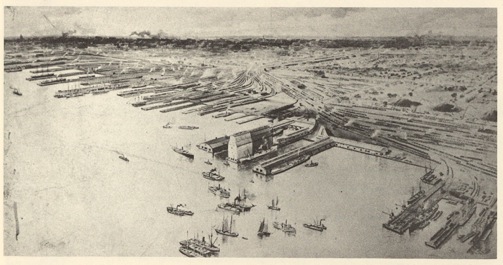
© Philadelphia Year Book, 1917.
PORT RICHMOND & BRIDESBURG
© Jack J. Steelman,
Workshop of the
World (Oliver Evans Press, 1990).
There are at least two
versions of how Bridesburg got its name. The first
centers on Joseph Kirkbride who settled in the area in
1801. As the operator and owner of the bridge across the
Frankford Creek, Kirkbride accumulated enough money to
purchase large tracts of land in what was then called
Point No Point. The name of the area soon became
Kirkbridesburg, the burg coming from the German ethnic
character of the community. As this version of the story
goes it was shortened to Bridesburg.
A second version rests on the tradition in the Frankford
Community of brides going to the river community for what
today would be called a "honeymoon." Some local residents
insist that the name Bridesburg came from this practice.
Whether the folklore is true or the Kirkbride story is
true bears little on the settlement of the community.
The original inhabitants of Bridesburg were the Lenni
Lenape Indians. In 1643, Swedes, led by Johanne Printz
settled in Bridesburg. A vision of the river ending
impressed these early settlers—thus the name Point
No Point." In the 1660s, more immigrants came and
received "Liberty Grants" from William Penn. These were
free grants of 80 acres given to anyone who purchased
5000 acres of land in Pennsylvania. The Swedes were soon
outnumbered by the German Catholics. In 1664 Penn
accepted the Swedes' offer to trade this land in Point No
Point for land in Conshohocken. Throughout these early
years Bridesburg was the river port for Frankford. Bridge
Street became the main road to the Bridesburg wharf. The
opening of the Frankford Arsenal in 1812 further
increased population and established Bridesburg as a busy
river stop.
Joseph Kirkbride was aided in his settlement of
Bridesburg by Alfred Jenks. In 1820 he established the
Bridesburg Manufacturing Company, a textile mill along
the Frankford Creek. The limited water flow of the creek
did not permit enlargement of the textile industry in
Bridesburg. A more important and lasting effect on the
neighborhood was the opening of the Tacony Chemical Works
in 1842. Founded by Frederick Lennig in 1819 the firm
attracted a large number of workers from Germany,
establishing that population as the dominant nationality
in early Bridesburg.
The major influx of the Polish population occurred
between 1900 and 1920. The Frankford leather plant of
Robert H. Foerderer Inc. originally hired Polish men to
work in curing the hides. This process consisted of
soaking hides for days in dog manure to soften it. The
smell of the manure and the need to handle the soaked
leather made this job unacceptable to most Philadelphia
workers. However, the new Polish immigrant, excluded from
most factory work in the city, flocked to Bridesburg for
work. Many of these men had come to America to seek their
fortune, hoping to return to their native Poland.
Unfortunately, World War I intervened and the Polish men
of Bridesburg could not return home, lest they be
arrested and imprisoned for 20 years as draft dodgers
under a law enacted during the war. With the end of the
war many Polish women migrated to join the men of the
town. This rapidly changed the ethnic character of the
Bridesburg from German to Polish.
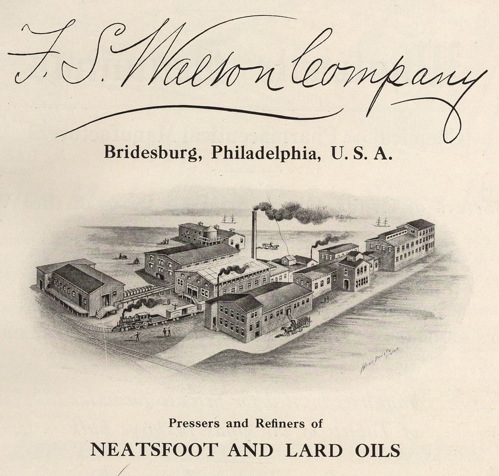
© Philadelphia
Year Book, 1917.
In 1894 the opening of the first trolley line in the
northeast connected Frankford, Bridesburg, Tacony, and
Holmesburg along State Road. Nicknamed the Hop, Toad, and
Frog Line it was used by many workers in Bridesburg.
Residents now had a chance to work at Henry Disston and
Sons Saw Works and Erben Search textile mill in Tacony,
and the Foerderer Leather Works near Frankford. Such
travel was so widespread that it was general knowledge in
Tacony that Polish women from Bridesburg made up half of
the Erben Search workforce.
In 1920 the Lennig Company was bought out by Rohm and
Haas, an already established chemical company. Haas had
come to America in 1906 bringing with him a new chemical,
Oropon, for curing leather. Acceptance of this chemical
by Foerderer initiated the opening of a Rohm and Haas
plant nearby and eventually in Bristol, Bucks County.
Rohm remained in Germany manufacturing the same chemical
for European use. This gave the company an international
flavor. The company stayed relatively small until World
War II when it developed a synthetic chemical which
produced plexiglas for fighters and bombers. It was this
discovery which catapulted Rohm and Haas into the
position as a world leader in chemical production.
Today Bridesburg is a community with several strong
social and service organizations. With endowments from
Rohm and Haas, the Civic Association of Bridesburg was
able to build the Boys and Girls Club in 1941. The Club
has conducted sports and other recreational activities
for the children of the community since that date.
Bridesburg is also a patriotic town. There are two
American Legion Posts, and a Veterans of Foreign Wars
Club, they oversee memorials saluting Bridesburg
veterans. Other institutions that play an important role
in preserving Bridesburg's history include churches of
various denominations, the Bridesburg Businessmen's
Association, and the Frankford Historical Society.
Although Bridesburg is located within a large urban area,
its atmosphere remains that of a small town community.
Located between the Delaware River and the Frankford
Creek its boundaries have changed little over the years.
Despite the closing of the Frankford Arsenal, Erben
Search Inc., Henry Disston and Sons, and Foerderer
Leather Works, Bridesburg remains an active industrial
community. It is the home of workers for Allied Chemical
Company and Rohm and Haas. Today Bridesburg remains one
of the largest Polish communities in Philadelphia.
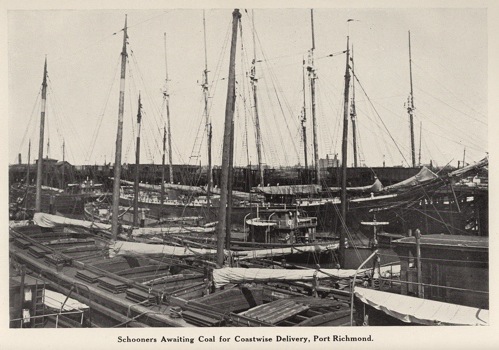
©
Philadelphia Year Book, 1917.
The Philadelphia and Reading Railroad completed its
trackage from the banks of the Schuylkill to the banks of
the Delaware in 1842 and shortly thereafter, in 1847, the
Richmond district was formed. 1
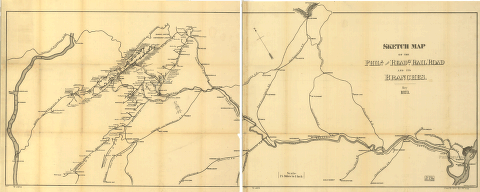
"Sketch map of Phila. and Readg. Rail Road
and its branches" (1873), terminating in Port
Richmond.
Most of the early growth of the area resulted from
development of the Port Richmond freight handling
facilities of the Reading; from the time of its early
construction until its dismantling in 1976, the Port
Richmond yards and docks constituted the largest
privately-owned tidewater terminal in the world, covering
over 230 acres. At one time, the piers received and
discharged cargoes destined to ports around the world as
well as to the Atlantic coastal trade. The freight and
coal storage yards west to Front Street had a capacity of
approximately 5,600 cars (based on 44' car lengths).
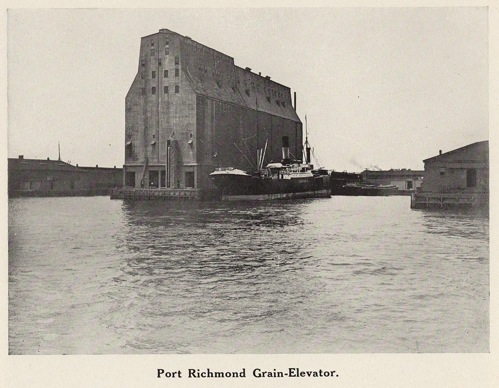
©
Philadelphia Year Book, 1917.
The
2.5 million bushel grain elevator, c.1928, was converted
to coal handling after Conrail took over operations;
ships were loaded at a rate of 25 million bushels per
hour, which translated to over 27 million bushels in a
single year. Pier 18, the Coal Dumper, built in 1918 (now
demolished), could unload one 55-70 ton car every two
minutes. Next upriver was Pier 14, the Ore Facility,
which had an unloading capacity of 400 tons per hour and
annually handled more than 1 million tons of imported
ore.
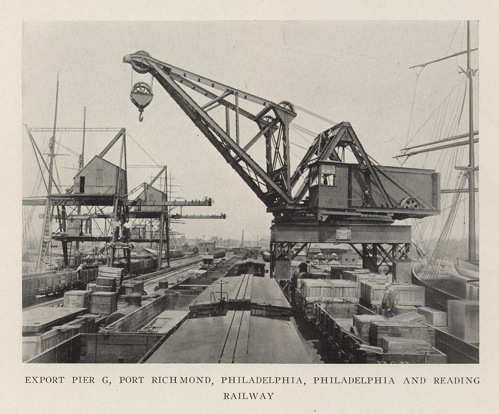
© Philadelphia
Year Book, 1917.
Another important
facility in the Terminal was the 100-ton Dock Crane,
located on Pier G; it was one of the largest on the
Atlantic Seaboard. The last pier in the terminal, located
near the Allegheny Avenue end, was Pier J, which
consisted of four car floats, each equipped to handle up
to five cars, that once moved over 100,000 cars per year
to New Jersey customers.
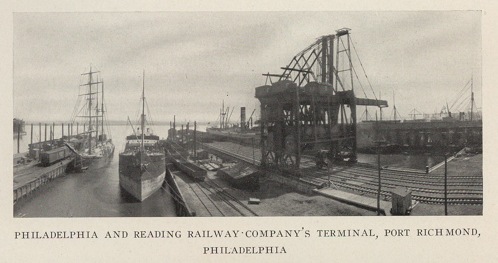
© Philadelphia
Year Book, 1917.
Coal was handled
primarily in the southern end of the facility. In this
area, a large shed containing five tracks, each capable
of handling six to eight cars, was constructed for
wintertime loading. The shed contained steam coils to
thaw frozen carloads of coal so that they could be dumped
into ships. Coal dumping was accomplished by one of two
means:
1. By electrically-powered "mules" which ran on
narrow-gauge tracks (between the standard gauge rails)
that hoisted the loaded cars, one at a time, up to a
rotating platform. Once positioned on the platform, the
wheels of the loaded car were locked onto the track and
the platform, with the car firmly secured, was flipped
over by steam-powered winches and the contents emptied
onto an apron that fed the falling coal into the hold of
the waiting ship. After the platform and car were
righted, the car was released to coast back into the yard
and the next one was shuttled into place by the mule.
2. The use of chutes placed on pier tracks that guided
the coal, which was systematically emptied from the
bottoms of the hopper cars, into the holds of the ships.
Obviously, the first method was faster, and certainly
much more dramatic.
Grain, raw sugar, and bulk
materials were also stored and handled at the Port
Richmond facilities. Interestingly, in the center of the
terminal was a small chapel, staffed by the Church of the
Assumption on Allegheny Avenue. It was originally
established so that merchant seamen would have a place to
worship that was close to their ship; however, it also
became a popular place for some of the neighborhood
families as it was close for them, too.
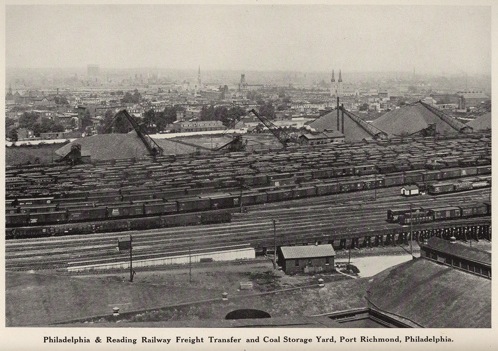
© Philadelphia
Year Book, 1917.
Since the closing
of the terminal in 1976, much of the trackage and piers
have been removed; the site now sits idle.
1 Richard Webster,
Philadelphia
Preserved, (Philadelphia, 1976), pp.
305 & 312.
Acknowledgements:
Thanks to Dr.
Harry Silcox, who prepared much of the overview
information on Bridesburg. Thanks also to John R. Bowie,
who assisted in the preparation of the material on the
sites. Thanks also to Frank Weer,
who contributed considerable information on the Port
Richmond facilities.
Resources:
Port Richmond - Bridesburg
bibliography